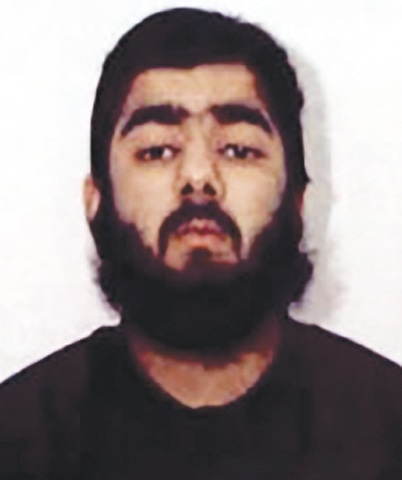LONDON: The Metropolitan Police on Saturday identified the suspected London Bridge attacker as British national Usman Khan, a 28-year-old man from Staffordshire.
Born in London, Khan is of Pakistani ethnicity.
“We are now in a position to confirm the identity of the suspect as 28-year-old Usman Khan, who had been residing in the Staffordshire area. As a result, officers are, tonight, carrying out searches at an address in Staffordshire,” said Assistant Commissioner Neil Basu in a statement issued past midnight.
Khan had stabbed two people to death and left three injured a day earlier in an attack that had caused fear and panic across the city as residents revisited the spectre of terror returning to London.
He was part of a gang of nine extremists from Stoke-on-Trent, Cardiff and London who were sentenced in February 2012 at Woolwich crown court. According to the sentencing remarks, he had planned to establish a “terrorist military training facility” on the land owned by his family in Kashmir.
“This individual was known to authorities, having been convicted in 2012 for terrorism offences,” said the assistant commissioner.
“He was released from prison in December 2018 on licence and clearly, a key line of enquiry now is to establish how he came to carry out this attack.”
Usman Khan was born in the UK
Basu said that Khan was shot dead by specialist armed forces. “The circumstances, as we currently understand them, are that the attacker attended an event earlier on Friday afternoon at Fishmonger’s Hall called ‘Learning Together’.
Reports suggest that Khan had been freed from prison on an electronic tag and that he was wearing a fake suicide vest when he attended the criminal justice conference near London Bridge.
He then began stabbing fellow delegates with two large knives. Khan is thought to have attended the morning session and participated in workshops in which he described his experiences as a prisoner, before launching his deadly attack without warning just before 2pm.
Basu also confirmed that police believed the attack began inside [Fishmonger’s Hall] before Khan left the building and proceeded to London Bridge, where he was detained and subsequently confronted and shot by armed officers.

Background
Khan — a British citizen born in the UK — appears to have left school with no qualifications after spending part of his late teens in Pakistan, where he lived with his mother when she became ill.
On his return to the UK, he started preaching ‘extremism’ on the internet and attracted a significant following.
In January 2012, Khan pleaded guilty to engaging in conduct in preparation for acts of terrorism contrary to Section 5(1) of the UK’s Terrorism Act 2006. Khan was among nine men charged with conspiracy to bomb high-profile London targets in the run-up to Christmas in 2010.
At the time, the men were described as an Al Qaeda-inspired group that wanted to send mail bombs to various targets and launch a “Mumbai-style” atrocity. At the time of his arrest, Khan lived in Stoke-on-Trent, a city in central England.
During the investigations, a hand-written target list found at one of the defendants’ homes listed the names and addresses of then London mayor Boris Johnson, the American Embassy and the Stock Exchange.
Khan was sentenced by a court to detention for public protection with a minimum custodial term of eight years — a sentence designed by the UK authorities to protect the public from serious offenders whose crimes did not merit a life sentence.
Offenders imprisoned for public protection have to spend a minimum term set for them in prison. Once they complete their tariff, they can apply to a parole board for release. The parole board releases an offender only if it is satisfied that it is no longer necessary for the protection of the public for the convict to be confined. If offenders are given parole, they will be on supervised licence for at least 10 years.
Initially, Khan was classed as never to be released unless deemed no longer a threat, but this condition was later removed. He was freed on licence in December 2018.
2010 bomb plot
The judge who had examined the sentencing appeals of Khan and the other convicts in 2013 had said: “They wished to support and commit acts of terrorism in furtherance of their religious beliefs. They came to the attention of the security services who monitored them using covert surveillance techniques and devices and were able to effect their arrest prior to advanced steps having been taken to implement their plans.”
He also noted that although they were from different parts of the country (Stoke, Cardiff and London), the groups managed to meet together.
The judge had also said that the Stoke defendants, including Khan, were recorded
discussing terror attacks overseas. On Dec 15, 2010, Khan had been monitored by the UK authorities in conversation about how to construct a pipe bomb from a recipe referred to in an Al Qaeda publication. The authorities also heard Khan seeking to radicalise another male and making clear his intentions to travel abroad to a training camp that outwardly appeared to be a seminary.
The Stoke group, which included Khan, were to fund the camp and recruit men for it. The court noted that Khan “expected only victory, martyrdom or imprisonment”.
Published in Dawn, December 1st, 2019















































